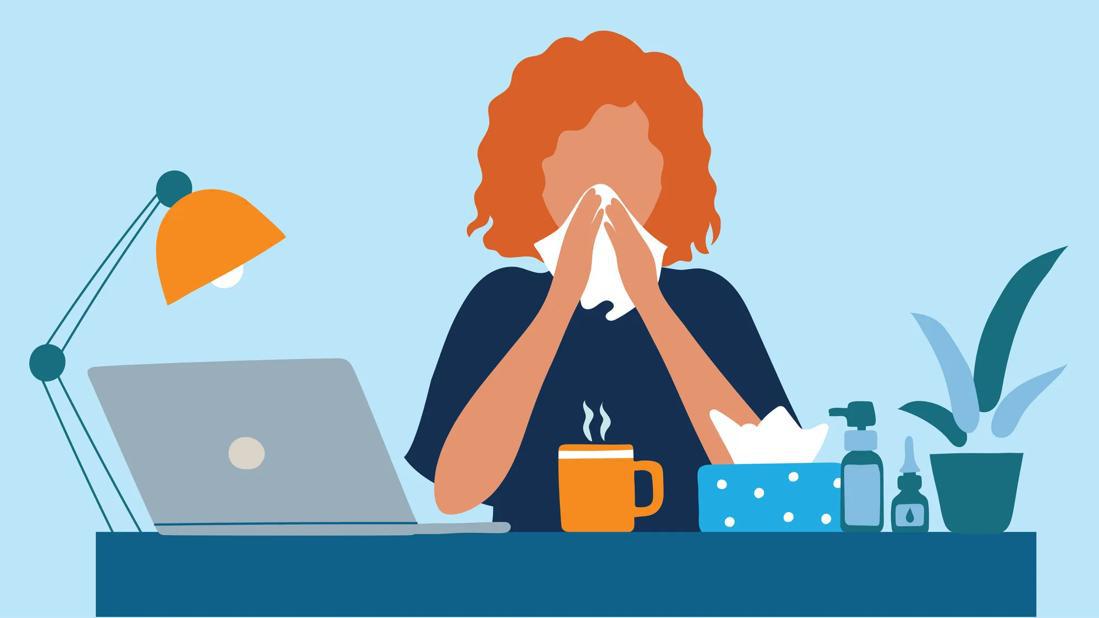Sinus Infection vs. Cold: How To Tell the Difference
Sinus infections tend to last longer and include symptoms like facial pressure and discolored mucus

Runny nose, headache, nagging cough… Are you dealing with a run-of-the-mill cold, or are these actually signs of a sinus infection? While it’s true that many of the symptoms overlap, there are a few ways to figure out the difference.
Rhinologist Troy Woodard, MD, explains how to know which one you have, plus tips for treating your symptoms.
How to tell if you have a cold or sinus infection
When it comes to the battle between a sinus infection and a cold, knowing which one you have can be tricky. To tell the difference between the two, Dr. Woodard recommends asking yourself these four questions:
- How long have you had symptoms? “Colds usually improve on their own,” Dr. Woodard says. “But if you start to feel worse after 10 or 14 days, that’s usually the point where it turns into a bacterial sinus infection.”
- Do you have sinus pressure? Sinus pressure happens when the lining of your nasal passages gets irritated or swollen — and it’s one of the main differentiators between colds and sinus infections. If you feel persistent facial pressure, pain or tenderness, suspect that your cold has transformed into something more.
- What color is your mucus? The color of your mucus (aka snot) may clue you in to what you’re dealing with. Clear discharge is typically a sign of a cold, while yellow or green discharge is often a sign of a sinus infection.
- Has your breath gotten worse? Sinus gunk that drains to your throat often has a foul smell. If bad breath has you reaching for mints or more frequent toothbrushing, it could be a sinus infection.
“A lot of the symptoms overlap,” Dr. Woodard reiterates. “But with sinus infections, those distinguishing factors are usually facial pressure and discolored drainage that lets you know that it’s turned bacterial.”
What causes each?
A cold is a virus at work in your upper respiratory system (encompasses your nose, mouth, throat and lungs). But sometimes, the mucus from a cold can block your sinuses and turn into a sinus infection.
A sinus infection occurs when the lining of your sinuses becomes inflamed. This prevents the sinuses from draining, sort of like a backed-up sewer.
“When swelling and nasal congestion block the sinus drainage, all that mucus builds up and becomes a breeding ground for bacteria to thrive,” Dr. Woodard explains.
But not all sinus infections are viral. They can also be caused by bacteria, fungus and even allergies — anything that causes enough mucus to clog up your sinuses.
Some people are more likely to get sinus infections than others. You may be prone to chronic sinusitis if you have:
- Environmental allergies
- Nasal polyps (small growths in your nasal lining)
- An immunodeficiency condition that weakens your immune system
Symptoms of colds and sinus infections
Cold and sinus infections often overlap. Both can bring:
- Runny nose
- Stuffy nose
- Postnasal drip (mucus dripping down your throat)
- Headaches
- Hoarseness
- Sneezing
- Tiredness or fatigue
- Body aches
- Watery eyes
What about fever? Though both conditions can cause your temperature to spike, this symptom is typically a sign of a cold.
“Viruses are more likely to be associated with fevers,” Dr. Woodard confirms. “It has to be a really severe sinus infection to cause a fever.”
We’ve already talked about the symptoms of a sinus infection. But for the sake of ease (who doesn’t love a list?), they’re worth repeating here. In addition to the symptoms named above, sinus infections often bring:
- Thick yellow or green mucus
- Facial pressure around your nose, eyes and forehead (it might get worse when you move your head around or bend over)
- Pressure or pain in your teeth
- Bad breath or a bad taste in your mouth
How to treat them
Viruses can’t be cured with antibiotics, so treating colds is mostly about improving your symptoms.
“It’s important to remember that with colds and other viruses, taking an antibiotic won’t help you feel better any faster,” says Dr. Woodard. “In fact, taking an antibiotic when you don’t need one can do more harm than good.”
Overusing antibiotics can lead to antibiotic resistance, which can make future infections harder to treat. Instead, Dr. Woodard advises focusing on doing things that will help you feel better and allow your body to heal.
“Get plenty of rest, stay hydrated and rinse out your sinuses with saline irrigation, which can help thin mucus and flush it from your nasal cavity,” he adds.
The same self-care habits can also help you through a sinus infection — but you may need to see a healthcare provider, too. Make an appointment if your symptoms don’t go away within 10 days, or if you have persistent symptoms like:
- Fever
- Discolored drainage
- Facial pressure
- Facial swelling
- Neck stiffness
“Sinus infections sometimes clear on their own, but antibiotics may shorten their duration,” Dr. Woodard notes. “As with colds, proper hydration and nasal irrigation can also ease sinus infection symptoms.”